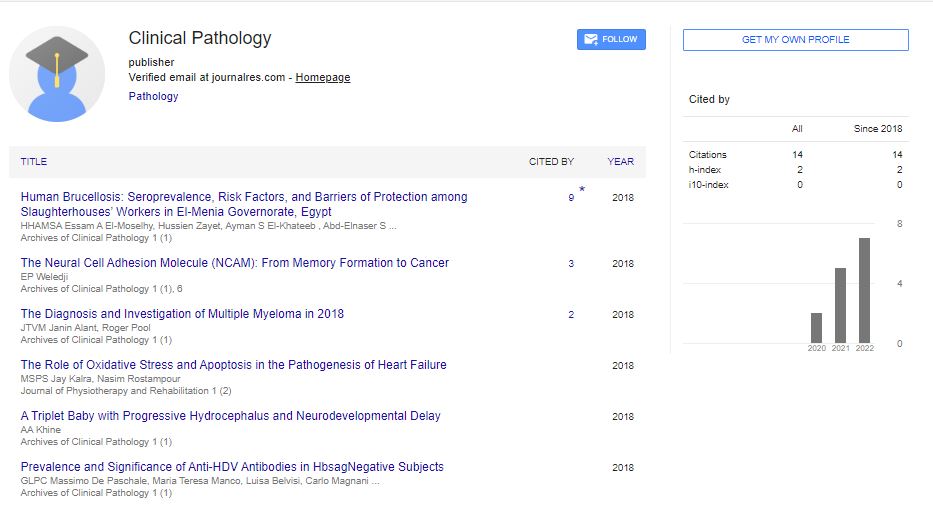Commentary, Arch Clin Pathol Vol: 6 Issue: 1
Potential of Haematology: Methods and Applications for Disease Diagnosis
Yasushi Lewin*
Department of Medicine, McMaster University, Hamilton, Ontario, Canada
*Corresponding Author: Yasushi Lewin
Department of Medicine, McMaster University, Hamilton, Ontario, Canada
E-mail: yasushilewin@mmu.ca
Received date: 20 February, 2023, Manuscript No. ACPY-23-96313;
Editor assigned date: 22 February, 2023, PreQC No. ACPY-23-96313 (PQ);
Reviewed date: 09 March, 2023, QC No. ACPY-23-96313;
Revised date: 16 March, 2023, Manuscript No. ACPY-23-96313 (R);
Published date: 23 March, 2023, DOI: 2324-8955/acpy.05.03.100076
Citation: Lewin Y (2023) Potential of Haematology: Methods and Applications for Disease Diagnosis. Arch Clin Pathol 6:1.
Description
Haematology, is the branch of medicine that deals with the study of blood, blood-forming organs, and blood-related disoders. It involves the diagnosis, treatment, and prevention of diseases of the blood, such as anaemia, bleeding disorders, and leukaemia. Hematology plays a vital role in modern medicine, as blood is essential for carrying oxygen and nutrients to the body's tissues and removing waste products from them . Haematology, a complex field that encompasses various sub-disciplines , including haemostasis and thrombosis, transfusion medicine, and haematological malignancies.
It involves the analysis of blood and bone marrow samples using sophisticated laboratory techniques to determine the presence of abnormal cells or substances. The results of these tests are used to make accurate diagnoses and inform treatment decisions. One of the essential applications of haematology is in the diagnosis and management of haematological malignancies, such as leukaemia and lymphoma. These diseases are characterized by the uncontrolled growth of abnormal blood cells, which can lead to a range of symptoms and complications. By using a variety of techniques; including blood and bone marrow biopsies, flow cytometry, and cytogenetic analysis, to identify the specific type of malignancy and determine the best course of treatment.
There are different types of methods used in haematology to diagnose and treat various blood disorders. Blood tests are the most commonly used method in haematology. These tests are done to check the levels of various components in the blood, such as red blood cells, white blood cells, and platelets. Blood tests can help diagnose anaemia, leukaemia, and other blood disorders. The Complete Blood Count (CBC) is the most common blood test done in haematology. This test provides information about the number and type of blood cells present in the blood. A bone marrow biopsy is a procedure that involves the removal of a small sample of bone marrow from the hip bone.
The bone marrow is the spongy tissue inside the bones that produces blood cells. This test is used to diagnose blood disorders such as leukaemia, lymphoma, and multiple myeloma. A bone marrow biopsy can also help determine the stage and severity of the disease. Coagulation tests are used to determine how quickly the blood clots. These tests are done to diagnose bleeding disorders such as haemophilia and von Willebrand disease. They can also be used to monitor the effectiveness of blood-thinning medications such as warfarin and heparin. Haemostasis and thrombosis, the study of blood clotting, is another vital area of haematology.
Abnormalities in blood clotting can lead to bleeding disorders, such as haemophilia, or thrombotic disorders, such as deep vein thrombosis. It involves a variety of tests, including clotting factor assays and platelet function tests, to diagnose these disorders and determine the most appropriate treatment. In addition to these clinical applications, haematology also has significant implications. The study of blood and blood-forming tissues provides insights into the mechanisms of disease and the development of new treatments. It is constantly exploring new approaches to diagnosing and treating blood-related disorders, including gene therapy, immunotherapy, and targeted therapies.
Conclusion
Haematology is an important field in modern medicine with farreaching applications in the diagnosis, treatment, and prevention of a range of diseases. The methods used in haematology have evolved over time, and new technologies are continuously being developed to enhance the accuracy and speed of diagnosis. Through ongoing studies and technological advancements, haematology will continue to improve the understanding of haematological disorders and develop new treatments and therapies that will benefit patients.
